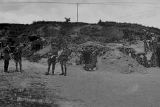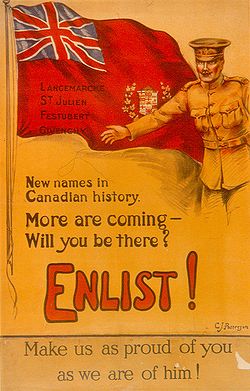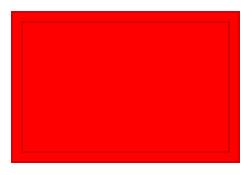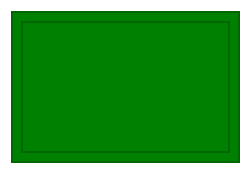
Canadian Corps
Encyclopedia
The Canadian Corps was a World War I
corps
formed from the Canadian Expeditionary Force
in September 1915 after the arrival of the 2nd Canadian Division
in France
. The corps was expanded by the addition of the 3rd Canadian Division
in December 1915 and the 4th Canadian Division
in August 1916. The organization of a 5th Canadian Division
began in February 1917, but it was still not fully formed when it was broken up in February 1918 and its men used to reinforce the other four divisions.
The majority of soldiers of the Canadian Corps were British-born until near the end of the war, when the number of those of Canadian birth who had enlisted rose to 51 percent. They were mostly volunteers, as conscription was not implemented until the end of the war (see Conscription Crisis of 1917
). Ultimately, only 24,132 conscripts made it to France before 11 November 1918. In the later stages of the war the Canadian Corps was regarded by friend and foe alike as one of the most effective Allied military formations on the Western Front
along with the Australians and New Zealanders.
 Although the corps was within and under the command of the British Expeditionary Force, there was considerable political pressure in Canada, especially following the Battle of the Somme, in 1916, to have the corps fight as a single unit rather than have the divisions spread out through the whole army. The corps was commanded by Lieutenant General
Although the corps was within and under the command of the British Expeditionary Force, there was considerable political pressure in Canada, especially following the Battle of the Somme, in 1916, to have the corps fight as a single unit rather than have the divisions spread out through the whole army. The corps was commanded by Lieutenant General
Sir E.A.H. Alderson, until 1916. Political considerations caused command to be passed to Lieutenant-General Sir Julian Byng. When Byng was promoted to a higher command during the summer of 1917, he was succeeded by General Sir Arthur Currie
, the commander of the 1st Division, giving the corps its first Canadian commander. Currie was able to reconcile the desire for national independence with the need for Allied integration. He resisted pressure to replace all British officers in high-ranking positions, retaining those who were successful until they could be replaced by trained and experienced Canadians.
The Canadian Corps captured Vimy Ridge in April, 1917
, in a daring attack that was a turning point in the war, and as Currie called it, "the grandest day the Corps ever had. During the German Spring Offensive
of the spring and summer of 1918, the Canadian Corps supported British and French soldiers while they held the Germans back. Between August 8 and 11, 1918, the corps spearheaded the offensive during the Battle of Amiens. Here a significant defeat was inflicted on the Germans, causing the German commander-in-chief, General Erich Ludendorff
, to call August 8 "the black day of the German army." This battle marked the start of the period of the war referred to as "Canada's Hundred Days
". After Amiens, the Canadian Corps continued to lead the vanguard of an Allied push that ultimately ended on 11 November 1918 at Mons where the British Empire had first met in conflict with Imperial German forces in 1914.
 At the end of war the Canadian 1st and 2nd Divisions took part in the occupation of Germany and the corps was eventually demobilized in 1919. Upon their return home the veterans were greeted by large and welcoming crowds all across the country. Total fatal battle casualties during the war was 56,638, 13.5% of the 418,052 sent overseas and 9.26% of the 611,711 who enlisted.
At the end of war the Canadian 1st and 2nd Divisions took part in the occupation of Germany and the corps was eventually demobilized in 1919. Upon their return home the veterans were greeted by large and welcoming crowds all across the country. Total fatal battle casualties during the war was 56,638, 13.5% of the 418,052 sent overseas and 9.26% of the 611,711 who enlisted.
"worked ceaselessly to convert all of its available political and physical resources into fighting power." One striking feature of the corps' evolution was its ability to exploit all opportunities for learning. This was a corps-wide activity, involving all levels from the commander
to the private soldier
. This ability to learn from allied successes and mistakes made the corps increasingly successful. Doctrine
was tested in limited engagements and, if proven effectual, developed for larger scale battles. Following each engagement, lessons were recorded, analyzed and disseminated to all units. Doctrine and tactics that were ineffective or cost too many lives were discarded and new methods developed. This learning process, combined with technical innovation and competent senior leadership in theatre
created one of the most effective allied fighting forces on the Western Front.
World War I
World War I , which was predominantly called the World War or the Great War from its occurrence until 1939, and the First World War or World War I thereafter, was a major war centred in Europe that began on 28 July 1914 and lasted until 11 November 1918...
corps
Corps
A corps is either a large formation, or an administrative grouping of troops within an armed force with a common function such as Artillery or Signals representing an arm of service...
formed from the Canadian Expeditionary Force
Canadian Expeditionary Force
The Canadian Expeditionary Force was the designation of the field force created by Canada for service overseas in the First World War. Units of the C.E.F. were divided into field formation in France, where they were organized first into separate divisions and later joined together into a single...
in September 1915 after the arrival of the 2nd Canadian Division
2nd Canadian Division
The 2nd Canadian Division was an infantry formation that saw service in the First World War. A 2nd Canadian Infantry Division was raised for the Second World War.-History:...
in France
France
The French Republic , The French Republic , The French Republic , (commonly known as France , is a unitary semi-presidential republic in Western Europe with several overseas territories and islands located on other continents and in the Indian, Pacific, and Atlantic oceans. Metropolitan France...
. The corps was expanded by the addition of the 3rd Canadian Division
3rd Canadian Division
The 3rd Canadian Division was a formation of the Canadian Corps during the First World War.The 3rd Canadian Division was formed in France in December 1915 under the command of Major-General M.S. Mercer. Its members served in both France and Flanders until Armistice Day...
in December 1915 and the 4th Canadian Division
4th Canadian Division
The Canadian Corps - 4th Canadian Division – World War I:The 4th Canadian Division was formed in the Britain in April 1916 from several existing units and others scheduled to arrive shortly thereafter. Under the command of Major-General David Watson, the Division embarked for France in August of...
in August 1916. The organization of a 5th Canadian Division
5th Canadian Division
The 5th Canadian Division of the Canadian Corps was formed during World War I. The 5th began assembling in Britain in February, 1917, but was broken up in February of 1918 before it was fully formed...
began in February 1917, but it was still not fully formed when it was broken up in February 1918 and its men used to reinforce the other four divisions.
The majority of soldiers of the Canadian Corps were British-born until near the end of the war, when the number of those of Canadian birth who had enlisted rose to 51 percent. They were mostly volunteers, as conscription was not implemented until the end of the war (see Conscription Crisis of 1917
Conscription Crisis of 1917
The Conscription Crisis of 1917 was a political and military crisis in Canada during World War I.-Background:...
). Ultimately, only 24,132 conscripts made it to France before 11 November 1918. In the later stages of the war the Canadian Corps was regarded by friend and foe alike as one of the most effective Allied military formations on the Western Front
Western Front (World War I)
Following the outbreak of World War I in 1914, the German Army opened the Western Front by first invading Luxembourg and Belgium, then gaining military control of important industrial regions in France. The tide of the advance was dramatically turned with the Battle of the Marne...
along with the Australians and New Zealanders.
History

Lieutenant General
Lieutenant General is a military rank used in many countries. The rank traces its origins to the Middle Ages where the title of Lieutenant General was held by the second in command on the battlefield, who was normally subordinate to a Captain General....
Sir E.A.H. Alderson, until 1916. Political considerations caused command to be passed to Lieutenant-General Sir Julian Byng. When Byng was promoted to a higher command during the summer of 1917, he was succeeded by General Sir Arthur Currie
Arthur Currie
Sir Arthur William Currie GCMG, KCB , was a Canadian general during World War I. He had the unique distinction of starting his military career on the very bottom rung as a pre-war militia gunner before rising through the ranks to become the first Canadian commander of the four divisions of the...
, the commander of the 1st Division, giving the corps its first Canadian commander. Currie was able to reconcile the desire for national independence with the need for Allied integration. He resisted pressure to replace all British officers in high-ranking positions, retaining those who were successful until they could be replaced by trained and experienced Canadians.
The Canadian Corps captured Vimy Ridge in April, 1917
Battle of Vimy Ridge
The Battle of Vimy Ridge was a military engagement fought primarily as part of the Battle of Arras, in the Nord-Pas-de-Calais region of France, during the First World War. The main combatants were the Canadian Corps, of four divisions, against three divisions of the German Sixth Army...
, in a daring attack that was a turning point in the war, and as Currie called it, "the grandest day the Corps ever had. During the German Spring Offensive
Spring Offensive
The 1918 Spring Offensive or Kaiserschlacht , also known as the Ludendorff Offensive, was a series of German attacks along the Western Front during World War I, beginning on 21 March 1918, which marked the deepest advances by either side since 1914...
of the spring and summer of 1918, the Canadian Corps supported British and French soldiers while they held the Germans back. Between August 8 and 11, 1918, the corps spearheaded the offensive during the Battle of Amiens. Here a significant defeat was inflicted on the Germans, causing the German commander-in-chief, General Erich Ludendorff
Erich Ludendorff
Erich Friedrich Wilhelm Ludendorff was a German general, victor of Liège and of the Battle of Tannenberg...
, to call August 8 "the black day of the German army." This battle marked the start of the period of the war referred to as "Canada's Hundred Days
Canada's Hundred Days
Canada’s Hundred Days was a series of attacks made along the Western Front by the Canadian Corps during the Hundred Days Offensive of World War I...
". After Amiens, the Canadian Corps continued to lead the vanguard of an Allied push that ultimately ended on 11 November 1918 at Mons where the British Empire had first met in conflict with Imperial German forces in 1914.

Canadian Divisions under the Canadian Corps
| Unit | Formation patch Formation patch Formation patches are types of military insignia developed during the 20th Century. Originally intended as battlefield identification of military formations, they have persisted into the 21stCentury as an element of military heraldry.-History:... |
Active | Commanders | Duration | Major battles |
|---|---|---|---|---|---|
| 1st Canadian Division 1st Canadian Division Formed in August 1914, the 1st Canadian Division was a formation of the Canadian Expeditionary Force. The division was initially made up from provisional battalions that were named after their province of origin but these titles were dropped before the division arrived in Britain on October 14,... |
 |
Established: August 1914 Disbanded: November 1918 |
Edwin Alderson Edwin Alderson Lieutenant General Sir Edwin Alfred Hervey Alderson KCB was a senior British Army officer who served in several campaigns of the late nineteenth and early twentieth centuries... |
March 1915 - Sept 1915 | Second Battle of Ypres Second Battle of Ypres The Second Battle of Ypres was the first time Germany used poison gas on a large scale on the Western Front in the First World War and the first time a former colonial force pushed back a major European power on European soil, which occurred in the battle of St... |
| Arthur Currie Arthur Currie Sir Arthur William Currie GCMG, KCB , was a Canadian general during World War I. He had the unique distinction of starting his military career on the very bottom rung as a pre-war militia gunner before rising through the ranks to become the first Canadian commander of the four divisions of the... |
Sept 1915 - June 1917 | Battle of Mont Sorrel Battle of Mont Sorrel The Battle of Mont Sorrel was a localized conflict of World War I between three divisions of the British Second Army and three divisions of the German Fourth Army in the Ypres Salient, near Ypres, Belgium, from 2 June 1916 to 14 June 1916.In an effort to pull British resources from the observed... Battle of the Somme Battle of Vimy Ridge Battle of Vimy Ridge The Battle of Vimy Ridge was a military engagement fought primarily as part of the Battle of Arras, in the Nord-Pas-de-Calais region of France, during the First World War. The main combatants were the Canadian Corps, of four divisions, against three divisions of the German Sixth Army... |
|||
| Archibald Cameron Macdonell Archibald Cameron Macdonell Lieutenant General Sir Archibald Cameron Macdonell, KCB, CMG, DSO was a Canadian police officer and soldier.-Education:... |
June 1917 - 1919 | Battle of Hill 70 Battle of Hill 70 The Battle of Hill 70 was a localized battle of World War I between the Canadian Corps and five divisions of the German Sixth Army. The battle took place along the Western Front on the outskirts of Lens in the Nord-Pas-de-Calais region of France between 15 August 1917 and 25 August 1917.The primary... Battle of Passchendaele |
|||
| 2nd Canadian Division 2nd Canadian Division The 2nd Canadian Division was an infantry formation that saw service in the First World War. A 2nd Canadian Infantry Division was raised for the Second World War.-History:... |
 |
Established: May 1915 Disbanded : Nov 1918 |
Sam Steele Sam Steele Major General Sir Samuel Benfield Steele, CB, KCMG, MVO was a distinguished Canadian soldier and police official... |
May 1915 - Aug 1915 | None |
| R. E. W. Turner Richard Ernest William Turner Lieutenant General Sir Richard Ernest William Turner VC, KCB, KCMG, DSO was a Canadian army officer during the Boer War and World War I, and a recipient of the Victoria Cross... |
Sept 1915 - Dec 1916 | Battle of the Somme Battle of Passchendaele |
|||
| Henry Edward Burstall Henry Edward Burstall Sir Henry Edward Burstall, was a Canadian general.-Education:Born at Domaine Cataraqui, Quebec City, Quebec, the son of the wealthy merchant John B. Burstall and Fanny Bell Forsyth, daughter of Joseph Bell Forsyth , the first Chancellor of Bishop's University and the builder of Domaine... |
Dec 1916 - Nov 1918 | Battle of Vimy Ridge Battle of Vimy Ridge The Battle of Vimy Ridge was a military engagement fought primarily as part of the Battle of Arras, in the Nord-Pas-de-Calais region of France, during the First World War. The main combatants were the Canadian Corps, of four divisions, against three divisions of the German Sixth Army... |
|||
| 3rd Canadian Division 3rd Canadian Division The 3rd Canadian Division was a formation of the Canadian Corps during the First World War.The 3rd Canadian Division was formed in France in December 1915 under the command of Major-General M.S. Mercer. Its members served in both France and Flanders until Armistice Day... |
Established: Jan 1916 Disbanded : Nov 1918 |
M. S. Mercer Malcolm Mercer Major-General Malcolm Smith Mercer, CB was a Canadian general, barrister and art patron who practiced law in Toronto and led the 3rd Canadian Division during the first two years of the First World War before he was killed in action at Mount Sorrel in Belgium... |
Dec 1915 - Jun 1916 (died in combat) |
Battle of Mont Sorrel Battle of Mont Sorrel The Battle of Mont Sorrel was a localized conflict of World War I between three divisions of the British Second Army and three divisions of the German Fourth Army in the Ypres Salient, near Ypres, Belgium, from 2 June 1916 to 14 June 1916.In an effort to pull British resources from the observed... |
|
| Louis Lipsett Louis Lipsett Major General Louis James Lipsett CB, CMG , was a senior officer in the British Army and Canadian Expeditionary Force during the First World War. He commanded the 3rd Canadian Division during some of the bitterest battles of the war, taking over in 1915 after his predecessor was killed... |
Jun 1916 - Sep 1918 | Battle of the Somme Battle of Vimy Ridge Battle of Vimy Ridge The Battle of Vimy Ridge was a military engagement fought primarily as part of the Battle of Arras, in the Nord-Pas-de-Calais region of France, during the First World War. The main combatants were the Canadian Corps, of four divisions, against three divisions of the German Sixth Army... Battle of Passchendaele |
|||
| Frederick Loomis Frederick Loomis Sir Frederick Oscar Warren Loomis enlisted as a private in the Canadian Militia in 1886 and served there until retiring in 1919. During the First World War he was given command of the Royal Highlanders of Canada and later led the 3rd Canadian Division during the last two months of the First World... |
Sep 1918- Nov 1918 | None | |||
| 4th Canadian Division 4th Canadian Division The Canadian Corps - 4th Canadian Division – World War I:The 4th Canadian Division was formed in the Britain in April 1916 from several existing units and others scheduled to arrive shortly thereafter. Under the command of Major-General David Watson, the Division embarked for France in August of... |
 |
Established: Apr 1916 Disbanded: Nov 1918 |
David Watson David Watson (general) Major General Sir David Watson, was a Canadian journalist, newspaper owner, and general.Born in Quebec City, Quebec, the son of William Watson and Jane Grant, Watson was a journalist with the Quebec Morning Chronicle... |
Apr 1916 - Nov 1918 | Battle of Vimy Ridge Battle of Vimy Ridge The Battle of Vimy Ridge was a military engagement fought primarily as part of the Battle of Arras, in the Nord-Pas-de-Calais region of France, during the First World War. The main combatants were the Canadian Corps, of four divisions, against three divisions of the German Sixth Army... Battle of Passchendaele Battle of Amiens Battle of Arras Battle of Arras (1917) The Battle of Arras was a British offensive during the First World War. From 9 April to 16 May 1917, British, Canadian, New Zealand, Newfoundland, and Australian troops attacked German trenches near the French city of Arras on the Western Front.... Battle of Cambrai Battle of Cambrai (1918) The Battle of Cambrai was a battle between troops of the British First, Third and Fourth Armies and German Empire forces during the Hundred Days Offensive of the First World War. The battle took place in and around the French city of Cambrai, between 8 and 10 October 1918... |
| 5th Canadian Division 5th Canadian Division The 5th Canadian Division of the Canadian Corps was formed during World War I. The 5th began assembling in Britain in February, 1917, but was broken up in February of 1918 before it was fully formed... |
 |
Established: Feb 1917 Disbanded: Feb 1918 |
Garnet Hughes Garnet Hughes Major General Garnet Burk Hughes CB, DSO, was a Canadian military officer during the First World War. He was the son of Sir Sam Hughes, a Canadian politician and Minister of the Militia during the war... |
Feb 1917 - Feb 1918 | None |
Battles
Following its formation in late 1915, the Canadian Corps readied to fight major battles as a unified entity, beginning in 1916. Additional actions were fought by one or more units of the corps (see separate listings for the divisions, above). Major battles fought by the corps were the following:1916
- Battle of Mount Sorrel: June 2–13
- Battle of Flers-CourceletteBattle of Flers-CourceletteThe Battle of Flers-Courcelette, was a battle within the Franco-British Somme Offensive which took place in the summer and autumn of 1916. Launched on the 15th of September 1916 the battle went on for one week. Flers-Courcelette began with the overall objective of cutting a hole in the German...
: September 15–22 - Battle of MorvalBattle of MorvalThe Battle of Morval, which began on 25 September 1916, was an attack by the British Fourth Army on the German-held villages of Morval, Gueudecourt and Lesboeufs during the Battle of the Somme. These villages were originally objectives of the major British offensive of 15 September, the Battle of...
: September 25 - Battle of Thiepval: September 26–28
- Battle of Le TransloyBattle of Le TransloyThe Battle of Le Transloy was the final offensive mounted by the British Fourth Army during the 1916 Battle of the Somme.-Prelude:With the successful conclusion of the preceding Battle of Morval at the end of September, the Fourth Army of Lieutenant General Henry Rawlinson had finally captured the...
: October 1–18 - Battle of the Ancre HeightsBattle of the Ancre HeightsThe Battle of the Ancre Heights was a prolonged battle of attrition in October 1916 during the Battle of the Somme. Lieutenant General Hubert Gough's Reserve Army had finally managed to break out of the positions it had occupied since the start of the Somme fighting and Gough intended to maintain...
: October 1 – November 11
1917
- Battle of Vimy RidgeBattle of Vimy RidgeThe Battle of Vimy Ridge was a military engagement fought primarily as part of the Battle of Arras, in the Nord-Pas-de-Calais region of France, during the First World War. The main combatants were the Canadian Corps, of four divisions, against three divisions of the German Sixth Army...
: April 9–14 - Battle of Arleux: April 28–29
- Third Battle of the Scarpe: May 3–4
- Battle of Hill 70Battle of Hill 70The Battle of Hill 70 was a localized battle of World War I between the Canadian Corps and five divisions of the German Sixth Army. The battle took place along the Western Front on the outskirts of Lens in the Nord-Pas-de-Calais region of France between 15 August 1917 and 25 August 1917.The primary...
: August 15–25 - Second Battle of Passchendaele: October 26 – November 10
- Battle of Cambrai (1917): November 20 – December 3
1918
- Battle of Amiens: August 8–11
- Second Battle of the SommeSecond Battle of the Somme (1918)During the First World War, the Second Battle of the Somme of 1918 was fought on the Western Front from the end of the summer, in the basin of the Somme River...
: August 21 – September 2 - Battle of the Canal du NordBattle of the Canal du NordThe Battle of Canal du Nord was part of a general Allied offensive against German positions on the Western Front during the Hundred Days Offensive of World War I. The battle took place in the Nord-Pas-de-Calais region of France, along an incomplete portion of the Canal du Nord and on the outskirts...
: September 27 – October 1 (including the capture of Bourlon WoodBourlon Wood MemorialThe Bourlon Wood Memorial is a Canadian war memorial that commemorates the actions of the Canadian Corps during the final months of the First World War; a period also known as Canada's Hundred Days, part of the Hundred Days Offensive...
) - Battle of CambraiBattle of Cambrai (1918)The Battle of Cambrai was a battle between troops of the British First, Third and Fourth Armies and German Empire forces during the Hundred Days Offensive of the First World War. The battle took place in and around the French city of Cambrai, between 8 and 10 October 1918...
: October 8–9 (including the Capture of CambraiCambraiCambrai is a commune in the Nord department in northern France. It is a sub-prefecture of the department.Cambrai is the seat of an archdiocese whose jurisdiction was immense during the Middle Ages. The territory of the Bishopric of Cambrai, roughly coinciding with the shire of Brabant, included...
)
Assessment
The military effectiveness of the corps has been extensively analyzed. The corps evolved steadily following the 1915 summer campaign. As Godefroy (2006) notes, the Canadian Expeditionary ForceCanadian Expeditionary Force
The Canadian Expeditionary Force was the designation of the field force created by Canada for service overseas in the First World War. Units of the C.E.F. were divided into field formation in France, where they were organized first into separate divisions and later joined together into a single...
"worked ceaselessly to convert all of its available political and physical resources into fighting power." One striking feature of the corps' evolution was its ability to exploit all opportunities for learning. This was a corps-wide activity, involving all levels from the commander
Commanding officer
The commanding officer is the officer in command of a military unit. Typically, the commanding officer has ultimate authority over the unit, and is usually given wide latitude to run the unit as he sees fit, within the bounds of military law...
to the private soldier
Private (rank)
A Private is a soldier of the lowest military rank .In modern military parlance, 'Private' is shortened to 'Pte' in the United Kingdom and other Commonwealth countries and to 'Pvt.' in the United States.Notably both Sir Fitzroy MacLean and Enoch Powell are examples of, rare, rapid career...
. This ability to learn from allied successes and mistakes made the corps increasingly successful. Doctrine
Military doctrine
Military doctrine is the concise expression of how military forces contribute to campaigns, major operations, battles, and engagements.It is a guide to action, not hard and fast rules. Doctrine provides a common frame of reference across the military...
was tested in limited engagements and, if proven effectual, developed for larger scale battles. Following each engagement, lessons were recorded, analyzed and disseminated to all units. Doctrine and tactics that were ineffective or cost too many lives were discarded and new methods developed. This learning process, combined with technical innovation and competent senior leadership in theatre
Theater (warfare)
In warfare, a theater, is defined as an area or place within which important military events occur or are progressing. The entirety of the air, land, and sea area that is or that may potentially become involved in war operations....
created one of the most effective allied fighting forces on the Western Front.
Further reading
- Christie, N. (1999). For King & Empire, The Canadians at Amiens, August 1918, CEF Books.
- Christie, N. (1997). For King & Empire, The Canadians at Arras, August – September 1918, CEF Books.
- Christie, N. (1997). For King & Empire, The Canadians at Cambrai, September – October 1918, CEF Books.
- Dancocks, D. (1987). Spearhead to Victory – Canada and the Great War, Hurtig Publishers
- Granatstein, J.Jack GranatsteinJack Lawrence Granatstein, OC, FRSC is a Canadian historian who specializes in political and military history.-Education:Born in Toronto, Ontario, Granatstein received a graduation diploma from Le College militaire royal de Saint-Jean in 1959, his BA from the Royal Military College of Canada in...
(2004). Canada's Army: Waging War and Keeping the Peace. Toronto: University of Toronto Press. ISBN 0802086969. - Morton, D.Desmond Morton (historian)Desmond Dillon Paul Morton, OC, FRSC, CD is a Canadian historian who specializes in the history of the Canadian military, as well as the history of Canadian political and industrial relations....
and Granatstein, J. (1989). Marching to Armageddon, Lester & Orpen Dennys Publishers. - Morton, D. (1993). When Your Number's Up, Random House of Canada.
- Schreiber, S. (2004). Shock Army of the British Empire – The Canadian Corps in the Last 100 Days of the Great War, Vanwell Publishing Limited.

